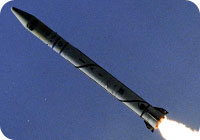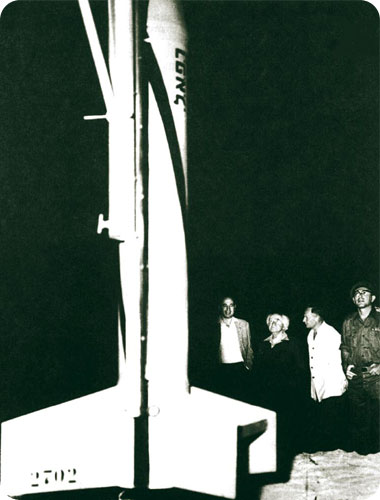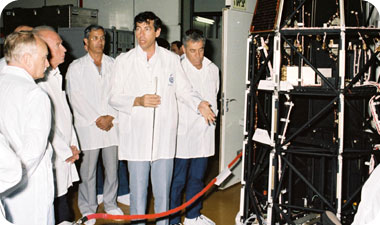The space infrastructure of the State of Israel places it in the first row of the developed countries in the world in terms of space technology. Below are milestones in the Israeli space program, key individuals and trends for the future * on the 20th anniversary of the launch of Ofek 1 * published in Galileo magazine, issue 122, September 2008 * first chapter in the series

Exactly 20 years ago, on September 19, 1988, the Israeli satellite launcher Shavit was launched from the Palmahim Air Force Base, with its bow under the sheath at the Israeli satellite reactor, Ofek 1. In doing so, Israel became the eighth member of the space club - countries that launched a satellite, which, like the launcher that carried it into space, developed in these countries without foreign aid.
The launch of Israel's first satellite concluded a continuous effort of years, which began in the early XNUMXs with the development of small rockets at Rafale, the Weapons Development Authority (today - Rafale Advanced Combat Systems Ltd.), and continued with the development of tactical missiles for use by the IDF and the establishment Human-scientific-technological infrastructure in the aerospace industry and other industries.
With the launch of Ofek 1 into space, the hopes of dreamers and people of action rose to new heights, who envisioned and established the space infrastructure of the State of Israel. Today, this infrastructure includes observation and communication satellites, which are used for a variety of security, civil and scientific applications, placing Israel in the first rank of the most developed countries in the world in terms of space technology.
Rockets and rockets made of wood
The beginning was much more modest, and was related to rockets and missiles made of wood (!), improvised rocket engines and surplus systems of the Second World War, bought as scrap. On the twenty-year anniversary of the launch of the first Israeli satellite into space, one can look back a little, and see how the State of Israel - then forty years old - reached a technological achievement that only superpowers and countries much richer than it had reached before.
In this review, milestones in the Israeli space program, key individuals in this program, and trends for the future will be noted. This article does not provide an overview of the entire history and activities of the Israeli space program, both because of the scope of its activities, and for weighty reasons of information security - many details related to the space program have not yet been allowed to be published. At the same time, it seems that it is possible to present a comprehensive picture of the Israeli space program on the twenty-year anniversary of its ability to launch an Israeli satellite on a home-made rocket.
In addition to the satellites that Israel develops, Israel is also active in the scientific field of space exploration, building experiments that are launched on satellites of other countries, and also sent an Israeli astronaut, the late Col. Ilan Ramon, into space for a flight on the American space shuttle Columbia, a flight that unfortunately ended in disaster and Her crew perished.
security and economic importance
The Israeli space program was born out of security needs, but with its development it became partly a plan has commercial aspects, And its economic contribution is much clearer today than at the beginning of its journey. It seems that today there is no longer any need to convince the country's captains of the necessity of owning observation satellites (this was not the case in the beginning, when the heads of the IDF Intelligence Division opposed the satellite program), nor is there any need to convince the general public, who benefit from satellite communication services. However, it seems that the Israeli space program is still struggling for its path, its focus and the financial means for its future expansion.

My hope is that the readers will share my opinion, that a national space program is a necessity, and that Israel's space capabilities must be strengthened and fortified, on all levels - in satellites, in a robust launcher program, in scientific-technological development, in education, and in partnerships with various entities in Israel and around the world.
The Israeli space program is a scientific-technological-economic engine, and if the State of Israel wants to strengthen its position in the international arena in these areas, it would do well to significantly increase the financial investment in this program.
Dates and landmarks in the Israeli space program
- 1958 - The Astronaut Association in Israel was established.
- 15.7.1961/2/XNUMX - Launch of Shavit XNUMX, the first Israeli rocket to reach the edge of space.
- 1963 - The Israel National Academy of Sciences established the National Committee for Space Research.
- 1966 - Tel Aviv University established the Space Sciences Institute.
- 1968 - The Israeli Association for Aviation and Space Sciences was established.
- 26.7.1972/XNUMX/XNUMX - The first relay station in Israel for satellite communication was inaugurated in Emek Elah.
- 1980 - Feasibility study at Rafael - Military Weapons Development Authority - which examined the possibility of building a light-weight photography satellite.
- 1981 - The Space Directorate was established in the Ministry of Defense.
- 23.1.1983 - The Israeli government decided on the establishment of the Israel Space Agency (the agency was established in April 1983).
- 1984 - Establishment of the space manager in the aerospace industry.
- 1984 - Asher Institute for Space Research was established at the Technion
- 19.9.1988 - Launch of Ofek 1, Israel's first satellite.
- 23.4.1990/2/XNUMX - Launch of Ofek XNUMX.
- 1992 - Israeli experiment in space: wasps were flown in the space shuttle to test their behavior in microgravity.
- 5.4.1995/3/XNUMX - Launch of Ofek XNUMX, Israel's first photography satellite.
- 16.5.1996 - Launch of Amos 1, Israel's first communication satellite.
- 22.1.1998/4/XNUMX - Launch of Ofek XNUMX. The launch failed due to a problem with the Comet launcher.
- 10.7.1998 - Launch of Gorwin Techsat, the Technion's first scientific satellite.
- 5.12.2000 - The launch of the Eros A satellite, Israel's first commercial photography satellite.
- 28.5.2002 - Launching Ofek 5.
- 16.1.2003 - Ilan Ramon launched into space - the first Israeli astronaut. Ramon perished in the space shuttle Columbia disaster on February 1.2.2003, XNUMX.
- 28.12.2003 - Launch of Amos 2, Israel's second communication satellite.
- 6.9.2004 - Launch of Horizon 6. The launch failed due to a problem with the comet launcher.
- 28.4.2006 - Launch of Israel's second commercial photography satellite, Fiance B
- 11.6.2007 - Launching Ofek 7.
- 21.1.2008 - Launch of Texar, the first radar satellite made in Israel.
- 28.4.2008 - Launch of Amos 3, Israel's third communications satellite.
Genesis days

In 1963, the National Academy of Sciences established the National Council for Space Research headed by Prof. Ernst David Bergman. The establishment of the council reflected the development and consolidation of the field of space research in the Israeli academy. At the same time as the academic activity and the establishment of the Israel Aerospace Sciences Association, research activity in the field of rocket propulsion began at the Weapons Development Authority - Rafale.
Rafael burst into public consciousness in 1961, with the launch of the Shavit 2 rocket to the edge of space. Shavit 2 was a two-stage rocket for meteorological research, powered by solid fuel, weighing 250 kg, which was launched on July 5, 1961 at 4:41 a.m. Morning from a launch site on the beach, and reached the edge of space at an altitude of 80 km. Upon its launch, photos were published around the world that showed Prime Minister David Ben-Gurion, Deputy Defense Minister Shimon Peres and other officials watching the launch.
The launch caused great excitement and pride in Israel. The timing of the launch, about a month before the elections to the Fifth Knesset, resulted in harsh criticism from the media and the opposition, claiming that it was chosen for election propaganda considerations.
The Voice of Israel reported on the launch in a laconic manner: "Today, 5 in Tammuz, July 1961, 04 at 41:XNUMX, a rocket for meteorological research was successfully launched into space from a shipping facility on the shores of the Mediterranean Sea. The rocket was designed, built and launched by a team of Israeli scientists and technicians. At the time of the launch, the prime minister and the defense minister, the foreign minister, the deputy defense minister and scientists were present at the launch site. The goals of the experiment were achieved." The launch was intended, as it later became known, to precede the launch of research rockets in Egypt, and was a propaganda achievement no less than a technological one.
Dr. Jonathan no (1922-2003), an engineer at Rafael and the pioneers of missile development in Israel, already in 1964 turned to the United States to help set up a satellite tracking station in Israel. In 1980, Tax wrote a feasibility study, which proved that it was possible to develop a satellite that would weigh only 240 kg and be able to provide photographs with high resolution. Rafael's satellite program was called Abir. Dr. Zeev Bonan, former CEO of Rafael, in his book "Rafael: From Laboratory to Campaign", crowned Yonatan Mass as the "father of the Israeli photography satellite". With the appointment of Moshe Arens as Minister of Defense, most of Israel's space activities were transferred to the Israel Aerospace Industries, and it became the maker of Israel's satellites.
For part B: a small space agency and a large industry

6 תגובות
Amber dew:
Your hope has come true with at least one reader.
I share your opinion that a national space program is a necessity, and that Israel's space capabilities must be strengthened and fortified, on all levels - in satellites, in a robust launcher program, in scientific-technological development, in education, and in partnerships with various entities in Israel and around the world.
: )
It is very interesting what they produced from:
1992 - Israeli experiment in space: wasps were flown in the space shuttle to test their behavior in microgravity.
I don't think the wasps navigated successfully.